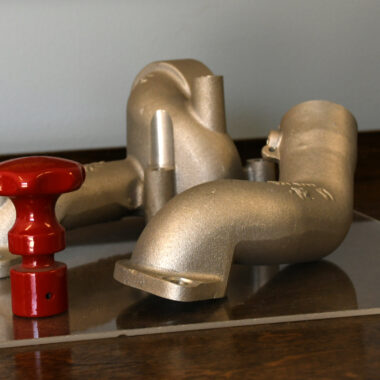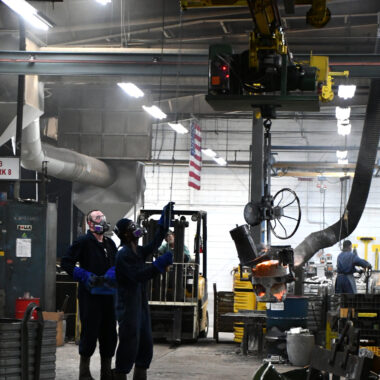Maximizing Performance: Advanced Aluminum Casting Solutions Revealed
Maximizing Performance: Advanced Aluminum Casting Solutions Revealed
Blog Article
Checking Out the Different Techniques of Aluminum Spreading: A Comprehensive Overview
Light weight aluminum casting stands as a basic process in the production of many products we come across daily, from intricate automobile parts to household components. Recognizing the diverse approaches utilized in aluminum casting is crucial for manufacturers looking for accuracy and effectiveness in their manufacturing processes - aluminum casting. As we begin on this expedition of the various methods associated with light weight aluminum casting, we discover a world where technology and practice converge to shape the products that form our contemporary world
Sand Spreading Technique
Making use of one of the oldest and most extensively made use of approaches in light weight aluminum spreading, the sand casting approach entails creating mold and mildews from a mix of sand and a binder material. This strategy is highly versatile, cost-effective, and ideal for generating a wide variety of shapes and dimensions, making it a preferred option in various sectors.

Aluminum, heated to its melting factor, is after that put into the mold and mildew, loading the cavity. After cooling down and solidifying, the sand mold and mildew is escaped, disclosing the light weight aluminum spreading. This approach permits the production of intricate geometries and is well-suited for both high and low volume manufacturing runs.
Financial Investment Casting Technique
Having explored the sand spreading method, a polished method to light weight aluminum spreading is the financial investment spreading strategy, which supplies distinctive advantages in regards to precision and surface finish. Financial investment spreading, also called lost-wax casting, is a procedure that includes developing a wax pattern that is coated with a ceramic covering. Once the shell is dried and set, it is heated up to eliminate the wax, leaving behind a hollow ceramic mold and mildew. Molten light weight aluminum is then poured into the dental caries, loading the mold and mildew to create the desired component.
Among the primary advantages of financial investment casting is its ability to create complex forms with high accuracy and detailed information. The procedure permits thin wall surfaces, sharp edges, and great surface finishes that require marginal post-processing. Furthermore, financial investment spreading is understood for its outstanding dimensional accuracy and limited tolerances, making it a recommended approach for creating components that require limited requirements. On the whole, the financial investment casting method is a flexible and reliable approach for manufacturing high-quality aluminum elements.
Irreversible Mold And Mildew Process

Among the crucial advantages of the Long-term Mold Refine is its ability to produce get rid of a finer grain structure, causing improved mechanical buildings. Additionally, the multiple-use nature of the metal mold and mildew enables the production of a large number of parts with constant top quality. This approach is frequently made use of in the automobile, aerospace, and marine industries for manufacturing components such as engine pistons, wheels, and architectural parts. By leveraging the Irreversible Mold and mildew Refine, producers can attain cost-efficient production of light weight aluminum parts with outstanding dimensional precision and surface area coating.
Pass Away Casting Method
In comparison to the Irreversible Mold And Mildew Refine, the Die Casting Technique for light weight aluminum spreading involves using a multiple-use steel mold and mildew to create elaborate get rid of high dimensional precision. This approach is extensively used in various markets as a result of its capability to effectively mass-produce intricate shapes with slim wall surfaces and superb surface area coatings.
Die casting generally starts with the preparation of the steel mold and mildew, which is then sprayed with a lubricating substance to help with the removal of the solidified aluminum. The mold and mildew is shut, and molten light weight aluminum is infused under high pressure into the dental caries. When the light weight aluminum cools down and solidifies, the mold opens up, disclosing the completed component.
One of the vital benefits of die casting is its high production rate, making it an affordable option for massive production. Additionally, parts generated with die spreading display remarkable stamina and durability contrasted to those made through other casting methods. This approach is specifically ideal for applications calling for intricate layouts, limited tolerances, and high repeatability.
Centrifugal Casting Technique
Just how can the Centrifugal Casting Technique enhance the efficiency and quality of light weight aluminum spreading procedures? Centrifugal spreading is an approach that utilizes centrifugal pressure to disperse molten steel into a mold tooth cavity. This technique offers several advantages over typical casting approaches.
One trick advantage is the remarkable high quality of the spreadings produced. The centrifugal force aids to get rid of porosity by pushing any kind of gas or contaminations his response towards the center of the casting, resulting in a denser and much more consistent last item (aluminum casting). Furthermore, the rotational movement of the mold and mildew ensures a more even distribution of the molten steel, causing boosted mechanical residential properties and decreased flaws
The technique enables for the casting of detailed forms and thin-walled parts with convenience, expanding the design possibilities for producers. In final thought, the Centrifugal Casting Approach stands out as a trusted technique for boosting both the performance and quality of aluminum spreading processes.

Conclusion
In final thought, the various techniques of light weight aluminum spreading provide one-of-a-kind advantages and qualities for different applications. Sand spreading offers versatility and cost-effectiveness, financial investment casting permits intricate designs, irreversible mold procedure ensures high-grade surfaces, pass away casting supplies high production prices, and centrifugal casting produces high-strength components. Understanding the distinctions between these techniques can assist manufacturers pick the most ideal method for their particular casting needs.
Having discovered the sand spreading method, a polished approach to aluminum casting is the financial investment casting technique, which supplies unique benefits in terms of accuracy and surface finish. Financial investment casting, additionally known as lost-wax spreading, is a procedure that involves creating this website a wax pattern that is coated with a ceramic shell.How can the Centrifugal Spreading Approach enhance the performance and top quality of aluminum spreading procedures? In verdict, the Centrifugal Casting Approach stands out as a dependable strategy for boosting both the effectiveness and top quality of light weight aluminum casting processes.
Sand casting uses flexibility and cost-effectiveness, investment casting enables for complex styles, permanent mold process makes certain high-quality surfaces, die casting supplies high production prices, and centrifugal casting produces high-strength elements.
Report this page